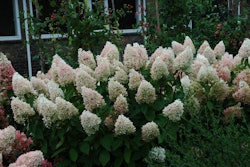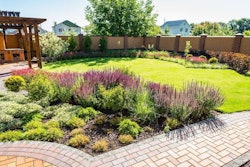 Hardy perennials add a splash of color to this rain garden.
Hardy perennials add a splash of color to this rain garden. Photo: Courtesy of Rain Dog Designs
Rain gardens may look like any other garden, but they have a secret: They’re incredible problem-solvers.
“Their main purpose is to capture water runoff from impervious surfaces such as rooftops, parking lots and driveways,” says Michael Dietz, Ph.D., extension educator at the University of Connecticut. “We’re trying to replicate nature so water sinks into the ground instead of going into stormwater systems.”
In some cities, sewer and stormwater systems are combined. The combined systems can’t handle the volume of water during heavy rains so sewage overflows into the nearest bodies of water. Runoff transports substances such as de-icing salt, chemicals and excess fertilizer into the water. “The more developed an area becomes, the more impact it can have on the streams and lakes due to runoff,” says Dietz.
It’s important to understand that rain gardens are not ponds or wetlands; they’re shallow depressions that collect, absorb and filter stormwater runoff. “It’s a misconception that there’s standing water,” says Jason Rathe, owner and lead designer of Field Outdoor Spaces in Minneapolis. “Properly designed rain gardens drain in less than a day.”
Correct drainage means mosquitoes are not an issue. Rain gardens also control erosion, prevent flooding, and provide habitat for pollinators and wildlife.
Follow these steps to use this design tool successfully:
Get trained
With some basic education, a rain garden is no more difficult to install than any other planting bed. “If you can install a plant, you can dig a rain garden,” says Rodney Stoutenger, president and lead designer of Native Edge Landscape in Austin, Texas. “The important things are learning to calculate the correct size to manage the water and choosing the right soil mix and plants.”
Design and installation classes are offered by organizations such as cooperative extension services, local watershed districts, nonprofit conservation organizations, landscape and trade associations, as well as universities. Or check out the University of Connecticut’s free rain garden app for advice on design and plant selection.
Evaluate the site
Place the garden where it can collect and filter the largest volume of water. For residences, that’s often near a downspout at the front of the house, says Rathe.
Water can be delivered to the garden by underground pipe, across a landscaped area, or through an open swale lined with rock. Commercial properties may require more engineering and may necessitate the services of a landscape architect, as there’s a larger volume of water to be handled.
 All water from downspouts on the back of the house is redirected into this rain garden. Photo: Courtesy of Field Outdoor Spaces.
All water from downspouts on the back of the house is redirected into this rain garden. Photo: Courtesy of Field Outdoor Spaces.Avoid placing rain gardens over utilities, wells, septic tanks or drain fields, and stay away from boggy spots because plants will not thrive. “Keep the garden at least five feet from crawlspaces and 10 feet from basements so you don’t send water back toward the house,” says Marilyn Jacobs, co-owner and designer of Rain Dog Designs in the Puget Sound area of Washington. “Also, look for a safe overflow area that doesn’t flood into the street or a neighbor’s yard.”
Check the soil percolation rate to ensure water will not stay pooled in the site of your choice. For the most basic test, dig a hole 6 to 8 inches deep and 4 to 5 inches round. Fill with water and time how long it takes to drain. If the water has not drained within 24 hours, the site may not be suitable due to issues such as a high water table or heavy clay, says Dietz.
Prep the site
Several factors impact how big the garden should be, Dietz says, including the volume of water that will drain to the garden, how much rainfall your area receives and how much space you have. Many residential rain gardens are 100 to 300 square feet while some are as large as 600 square feet. Check with your extension service or watershed district for the correct equation to calculate the appropriate size based on local conditions, or try the University of Connecticut’s sizing map.
 Rain gardens clustered along a residential street protect a nearby river. Photo: Courtesy of Rain Dog Designs.
Rain gardens clustered along a residential street protect a nearby river. Photo: Courtesy of Rain Dog Designs.Most contractors excavate all soil from the site and replace it with a medium that is nutrient-rich. Typically, says Native Edge Landscape’s Stoutenger, about 12 to 18 inches of soil is removed and replaced with compost. The garden is situated somewhat lower in grade to capture the rain water, but the depression often is not apparent once plantings are installed. Excavated soil is used to create a berm along one side, allowing water to be retained during heavy storms.
Choose the right plants
A variety of perennials, shrubs and even small trees should be used to provide multi-season interest. Choose natives and plants hardy to your region. The sides of the garden should slope gently, with plantings placed in zones, says Jacobs. The first zone, at the base of the garden, is for plants that can bear wet feet. The next zone contains plants on the slopes that can tolerate occasional standing water. The last zone, which is on the perimeter of the garden, is made up of plants that prefer dry conditions.
A common misconception is that a rain garden looks wild and informal. “It can appear more manicured and controlled based on the design and plant materials selected,” says Rathe. “Incorporate it into the existing landscape so it’s a component, not just a little oval sitting in the middle of the yard.” Edge with flagstones or pavers, and top-dress with a layer of shredded hardwood mulch, which won’t float away like bark or pine straw.









